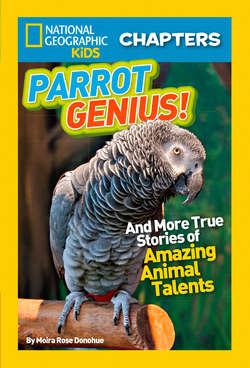Читать книгу National Geographic Kids Chapters: Parrot Genius: And More True Stories of Amazing Animal Talents - Moira Donohue Rose - Страница 7
Оглавление
One day Teresa had a brainstorm. Einstein lived in a zoo with all kinds of animals. Would the parrot enjoy making animal sounds? Teresa wondered. So Teresa howled like a wolf. “Aaooo!”
“Aaooo!” Einstein howled back.
“Whoo, whoo, whoooo!” Teresa hooted like an owl.
“Whoo, whoo, whoooo!” Einstein hooted back. Einstein loved to imitate animal sounds.
After a while, Teresa decided to teach Einstein to make these sounds “on cue.” That means making a sound in response to a question. It was harder to teach—and to learn!
First, Teresa waited for Einstein to copy a sound, like “meow.” She gave Einstein a treat. Then she asked a question. “What does a cat say?” When Einstein said “meow” again, she got another treat. This time she got a big treat—a peanut! Teresa did this over and over. Soon Einstein said “meow” whenever Teresa asked her what a cat said.
One time Einstein heard a funny sound and started repeating it. It sounded like “Arrgh.” It made her trainer think of a pirate. Pirates often had colorful parrots on their shoulders. So her trainer said, “What do pirates say?”
Did You Know?
Crows are also very intelligent birds. They can make and use tools. One crow was filmed making a wire hook to get food!
“Arrgh,” said Einstein. Teresa and Einstein said it over and over. In just a couple of hours, Einstein had a new sound on cue!
Teresa and the other trainers picked out new sounds for Einstein to learn. When they agreed on one, they would all say it to her whenever they saw her. Before long, Einstein could make 200 sounds, including many animal noises! That’s more than almost any other parrot, even other African grays.
Einstein stood out because she knew a lot of sounds. And she learned fast. But there are other parrots that can make a lot of sounds. What makes Einstein extra special is that she remembers sounds on cue. Most other parrots can only remember 13 or 14 sounds on cue at a time. But that’s not how Einstein’s brain works. She doesn’t forget old cues when she learns new ones. Einstein knows 85 words on cue. She really is amazing!
Does Einstein understand what she’s saying? Her trainers say that’s a hard question to answer. Sometimes the parrot says something that isn’t right. One time, her trainer said, “Make an evil laugh.” Usually Einstein says, “Nyah-ah-ah.” But this time, Einstein said, “I love you.”
But sometimes she says things that make a lot of sense, even if she isn’t given a cue. One day a trainer was eating in front of her. “What are you doing?” Einstein asked. She cocked her head. She was looking for a treat. When the trainer didn’t give her one, she said, “Mmmmm,” like we say when something tastes really good. No one taught her that! Soon she started doing it whenever a trainer was eating. She was training her trainer to give her a treat!
Once Einstein didn’t get a treat when she said “Mmmmm.” To get her trainer’s attention, she lay on her back in her cage. She stuck her feet in the air. She looked right at her trainers. “What are you doing, sweetheart?” she asked. Her trainers thought she was complaining because she wasn’t getting a treat. They laughed really hard and gave her one.
Dr. Irene Pepperberg, a scientist, believes that parrots understand language. She wanted to prove her idea. She had a parrot, an African gray parrot named Alex. She trained him and studied him for 30 years. Alex learned over 150 words. And he showed signs of understanding language. So maybe when Einstein seems to understand, she really does!
Even though Einstein knew a lot of words, she had other things to learn before she would be ready for the zoo’s show. Her trainers taught her to get in and out of her cage when she was told. And they gave her treats when she stayed on her perch. But she had one more important thing to learn.
Scientists have taught apes to understand human language. Dr. Pepperberg tried to do the same thing with her parrot, Alex. She showed him different colored things. Then she asked him to pick out something blue. He did, over and over. She asked him how many items he saw. He would count up to six things. Sometimes Alex asked for something. If Dr. Pepperberg gave him the wrong item, he told her. She thought this showed that he could understand.
